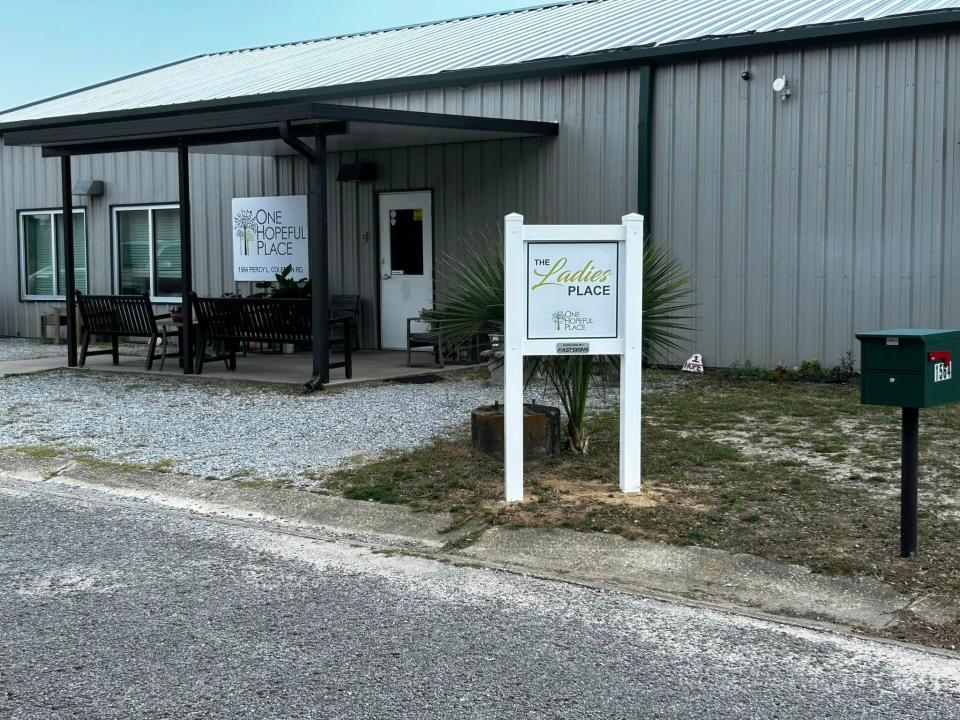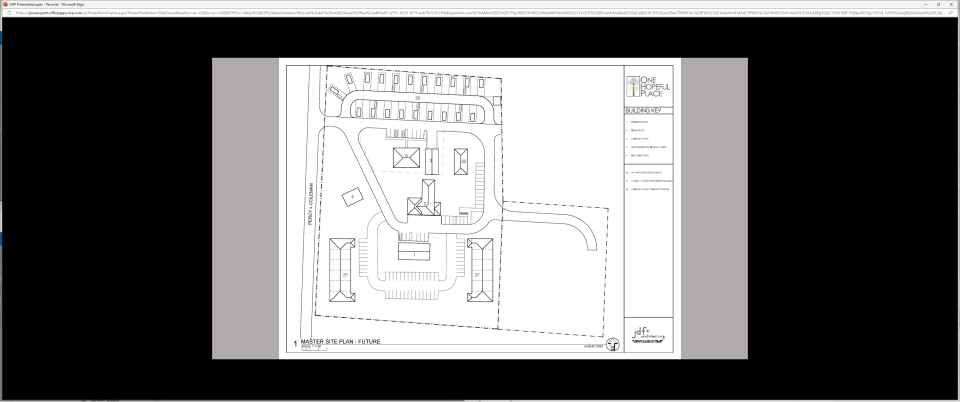Fort Walton Beach community offers a plan to help the homeless; City Council pushes back.
FORT WALTON BEACH — After the four new members of the Fort Walton Beach City Council were elected into office, one of their priorities related to public safety and vagrancy. On Tuesday, the city council hosted its first workshop on this issue.
Current estimates show there are at most 200 people within the Fort Walton Beach metro who are classified as homeless. To help that homeless population, the Greater Fort Walton Beach Chamber of Commerce, with the help of other entities in the city, put together a comprehensive plan that was brought before council members.
The plan has requested the use of city funds from the upcoming city budget to get the initiatives in place as soon as possible. The chamber asks the city council for $520,000 to update the facilities at One Hopeful Place.
Overview of One Hopeful Place
One Hopeful Place is one of the two homeless shelters in Okaloosa County. Located in Fort Walton Beach, OHP currently has a population of 50 men and 17 women.
The idea of OHP can be dated back to 2006, when leadership at the Fort Walton Beach Chamber first wanted to address homelessness. By 2012, the chamber had created a non-profit called Community Solutions of the Emerald Coast.

By 2016, with the help of state Sen. Don Gaetz and state Rep. Matt Gaetz, who lobbied the state for a $300,000 grant allocated to OHP, the facility began to serve a portion of the community that needed their help. The location currently sits on a former water treatment facility.
By 2020, OHP began a partnership with the Bridgeway Center (BCI), which now oversees the day-to-day operation of OHP. BCI specializes in primary care, mental health, psychiatric medicine and substance use services.
Housing First
The first step that was discussed with city council was an overview of an initiative by the National Alliance to End Homelessness called Housing First. Established by HUD, the approach is guided by the belief that people must first address their basic needs, like food and a place to live. Unlike other approaches, Housing First doesn't demand individuals to resolve their problems before meeting their housing needs.
Housing First has decreased homelessness by 88 percent and improved housing stability by 41 percent compared to programs that offer treatment first. According to data provided by NAEH, putting homeless individuals in housing would be more cost-effective. On average, it would save $31,545 per person over a two-year period.
Organizations involved
With Ted Corcoran from the Greater Fort Walton Beach Chamber of Commerce helping to spearhead the charge, other entities are joining the chamber in this planned citywide initiative. Other entities involved include:
Catholic Charites
Greater Peace Missionary Baptist Church
Fort Walton Beach First United Methodist Church
Taking it to the Streets
One Hopeful Place
Bridgeway Center
Homeless Housing Alliance
Innisfree
Okaloosa Techincal Center
Okaloosa County
Blue Wint Technology
United Way
Fort Walton Beach Housing Authority
Step One: Finding Mother Teresas
The first step in this four-part plan is to hire two individuals to oversee the operations of OHP. Corcoran refers to these people as "Mother Teresas." The team that will be used to hire these individuals will be the chair of the Homeless Housing Alliance, Eva Wise, and the CEO of the Bridgeway Center, Bonnie Barlow.
Barlow explained that the two individuals who will be hired will be a social worker and a medical professional.
"They will build relationships, establish trust. They will figure out that barrier before coming into care," said Barlow. "This outreach specialist program is key to getting the most chronic homeless individuals into shelter."
This is planned to cost $120,000.
Step Two: facility changes
The second step in the plan would be a conversion of One Hopeful Place cold weather shelter. According to Larry McFarland, the chief clinical officer of One Hopeful Place, the current cold weather shelter is only open 25 days a year on average.
With a conversion, the building would be turned into a 46-bed short-term living facility that individuals could use to transition to long-term housing.
"What we are asking for is $200,000 to get this facility up and operational," said McFarland. "That's $11 dollars a day per person to get someone off the street and give them the chance to move forward."
Corcoran explained that Pastor Joe Wilson from Taking it to the Streets did a straw poll during one of his religious services. In that poll, 70 percent of the homeless congregation said they would be willing to go to One Hopeful Place to have a roof over their head.
Step Three: county help
By using the Okaloosa County public transit system EC Rider, individuals could get free or reduced transportation to and from OHP. Another thing John Hofstad explained is that there is a potential for EC-Rider to change their route schedule, along with adding a covered bus stop with a bench that would be used as the OHP stop.
Innisfree Hotels already has an established partnership with One Hopeful Place, with active hiring and employment services. In the future, Innisfree plans to have training programs once a month to train in the hospitality sector, thus giving residents of OHP a jump start on income-making opportunities.
Step Four: long-term goals
Corcoran explained that the previous steps were all short-term goals. When he invited the Northwest Florida Daily News on a tour of One Hopeful Place, he explained that the time frame of the previously mentioned initiatives could take up to 90 days to complete.

"It would be our Christmas gift to the city," Corcoran said on the tour.
A five-acre parcel of adjacent land borders One Hopeful Place to the south, which the county owns. If OHP could acquire that land, the planned improvements that could be added would be up to 20 tiny houses that would be built by their partnership with Okaloosa Technical Center. OHP could also have the space to build two two-story apartment complexes that would be available for rent by the residents.
OHP would have to buy the tiny houses from OTC. Corcoran said the initiative could be a "win-win" for everyone involved. Students at OTC would be able to get the hands-on training they need for their education while OHP gains transitional housing as residents at OHP would enter the final phase of their time at the facility.
OHP is asking for $200,000 for this part of the project.
County Commissioner Trey Goodwin's thoughts
Although County Commissioner Goodwin could not attend the workshop on Tuesday afternoon, he provided a statement on the One Hopeful Place initiative.
"Okaloosa County recognizes that there is a population of people experiencing homelessness here, and we have opportunities to address this issue for their betterment and the betterment of our community as a whole. We have many non-profits, churches, and volunteers that are already doing great work with this effort. One Hopeful Place is one of these amazing organizations. I believe together we could expand on what they have built over the many years."
State funding options
Corcoran told the council that state Rep. Pat Manney did allocate $200,000 as a grant for One Hopeful Place. Rep. Manney could not make the meeting, but Henry Kelly of Blue Wind Technology did offer his thoughts as a lobbyist in Tallahassee.
"If the council allocates money for One Hopeful Place, then we return to the Legislature and say we took your $200,000 and we doubled it," said Kelly. "The more you can allocate makes it easier to ask for more."
FWB Police Department
During a Wednesday interview with Corcoran, he explained that the local police department comes into play by being the boots on the ground as their officers would interact with these people on the street.
By officers reaching out to the homeless population, they could then inform them of the opportunities that are available and offer assistance.
Chief Robert Bage explained during the meeting that they could use One Hopeful Place as a holding area for these individuals while things behind the scenes, if an arrest were to happen, played out over the course of a couple of days.
"When I first got here, I felt like I was swimming upstream," Bage said. "Change is coming. The nonprofits have gotten behind a plan that can work for everybody. This plan is not my plan, not the nonprofits' plan. It's a community plan that will resolve a lot of the issues we have."
City Council thoughts
Council Member Travis Smith's main concern was that by providing more services at One Hopeful Place, Fort Walton Beach could see an influx of homeless individuals entering the community.
"This could increase the density within our city limits," said Smith. "That's what our residents are kinda tired of and over it."
Councilman Payne Walker also shared these thoughts that echoed Councilman Smith.
"Within due time, it will be full, and they will be coming from far and wide because they hear of the great service that we provide," Walker said. "We look at some of the larger cities in the U.S.; it just keeps getting worse, and we just keep feeding the machine that says it's going to get better."
Walker then asked Corcoran for clarification on funding that totaled $520,000. By renaming the partners that came up with the plan, Corcoran shared that he believed this plan was the best way to attack this issue, which was unanimously approved by the council as its strategic plan.
"$520,000 addresses your No. 1 strategic plan," said Corcoran. "If you have another plan, we would love to hear it, but the community feels that this is it."
Walker pushed back, asking why the members of the Chamber of Commerce don't fund the project by using a one-time charge. Walker then explained how he believed that this issue should come from the private sector instead of using taxpayer funds.
Councilman Walker, Councilman Bryce Jeter and Councilwoman Gloria DeBerry said they would make donations from their own wallets that would help fuel a private collection fund.
The proposed Fort Walton Beach budget for the next fiscal year is $53 million.
"The taxpayers are saying this is the plan," said Corcoran. "This is an issue of yours that you have indicated that needs a solution. We recommend you take it."
What's next?
Corcoran then recommended that this issue be put on the agenda for an upcoming Fort Walton Beach City Council meeting.
"It's your No. 1 issue," Corcoran said in closing. "We have come and offered an idea."
This article originally appeared on Northwest Florida Daily News: Homelessness initiative offers comprehensive plan for change

